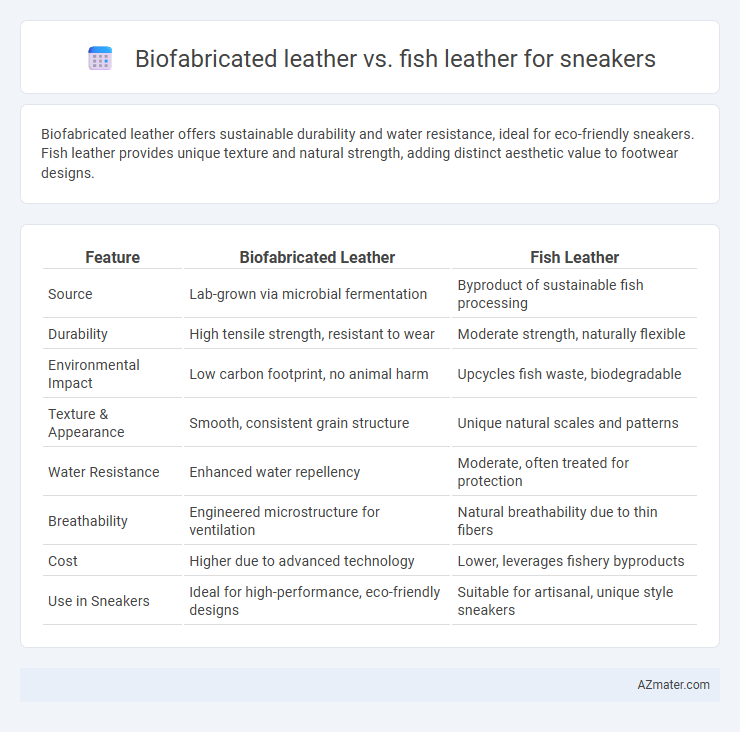Biofabricated leather offers sustainable durability and water resistance, ideal for eco-friendly sneakers. Fish leather provides unique texture and natural strength, adding distinct aesthetic value to footwear designs.
Table of Comparison
| Feature | Biofabricated Leather | Fish Leather |
|---|---|---|
| Source | Lab-grown via microbial fermentation | Byproduct of sustainable fish processing |
| Durability | High tensile strength, resistant to wear | Moderate strength, naturally flexible |
| Environmental Impact | Low carbon footprint, no animal harm | Upcycles fish waste, biodegradable |
| Texture & Appearance | Smooth, consistent grain structure | Unique natural scales and patterns |
| Water Resistance | Enhanced water repellency | Moderate, often treated for protection |
| Breathability | Engineered microstructure for ventilation | Natural breathability due to thin fibers |
| Cost | Higher due to advanced technology | Lower, leverages fishery byproducts |
| Use in Sneakers | Ideal for high-performance, eco-friendly designs | Suitable for artisanal, unique style sneakers |
Introduction to Sustainable Sneaker Materials
Biofabricated leather and fish leather represent innovative sustainable sneaker materials that reduce environmental impact compared to traditional leather. Biofabricated leather is produced through microbial fermentation, creating leather-like textures with lower greenhouse gas emissions and water usage. Fish leather utilizes byproducts from the fishing industry, offering a durable, biodegradable alternative that promotes waste valorization and circular fashion principles.
What is Biofabricated Leather?
Biofabricated leather is an innovative material created through lab-based processes that cultivate animal cells or microbes to produce sustainable leather without traditional animal farming. Unlike fish leather, which is derived from the skins of fish through conventional tanning methods, biofabricated leather offers a cruelty-free and environmentally friendly alternative with customizable textures and properties ideal for sneakers. This cutting-edge approach reduces carbon footprint and resource consumption while providing durable, high-performance materials for footwear designers.
Understanding Fish Leather: Origins and Process
Fish leather, a sustainable alternative derived from the skins of various fish species such as salmon, perch, and cod, undergoes a meticulous tanning process that preserves its natural texture and strength. This material retains the unique scale patterns and durability intrinsic to fish skin, making it an ideal choice for high-quality sneaker manufacturing due to its flexibility and resistance to wear. The eco-friendly tanning methods used in fish leather production reduce environmental impact compared to traditional leather processing, highlighting its appeal in sustainable sneaker design.
Environmental Impact: Biofabricated vs Fish Leather
Biofabricated leather for sneakers offers a significantly lower environmental impact by reducing water usage and greenhouse gas emissions compared to traditional fish leather, which relies on fishing practices that can contribute to overfishing and ecosystem disruption. Fish leather production involves tanning processes that often use hazardous chemicals, leading to water pollution, whereas biofabricated leather is produced through sustainable fermentation and cell culture techniques that minimize waste and energy consumption. Overall, biofabricated leather presents a more eco-friendly alternative by eliminating dependence on animal-derived materials and promoting circular bioeconomy principles.
Performance and Durability Comparison
Biofabricated leather offers superior tensile strength and abrasion resistance compared to fish leather, enhancing sneaker performance under rigorous use. Fish leather, known for its unique texture and natural flexibility, provides adequate durability but tends to wear faster with constant friction and moisture exposure. The molecular structure of biofabricated leather delivers enhanced water resistance and longevity, making it a more reliable choice for high-performance sneakers.
Aesthetic Qualities and Design Flexibility
Biofabricated leather offers unparalleled design flexibility with its customizable textures and colors, allowing sneaker designers to create innovative, modern aesthetics that mimic traditional leather or explore futuristic looks. Fish leather provides unique natural patterns and a distinct grain, lending a niche, exotic aesthetic ideal for premium or artisanal sneaker designs. Both materials support sustainable fashion trends, but biofabricated leather excels in scalability and uniformity, while fish leather emphasizes organic individuality.
Ethical Considerations in Material Sourcing
Biofabricated leather, produced through cellular agriculture, offers a cruelty-free alternative by eliminating the need for animal farming, significantly reducing ethical concerns tied to animal welfare. Fish leather, though sustainable by utilizing byproducts from the fishing industry, still relies on animal-derived materials, posing ethical questions about marine life exploitation. Choosing biofabricated leather supports a more ethical supply chain by prioritizing animal-free production while fish leather emphasizes waste reduction but retains some ethical complexities related to sourcing.
Cost and Scalability for Mass Production
Biofabricated leather offers a scalable alternative to traditional fish leather, with production costs gradually decreasing as technology advances and industrial-scale bioreactors become more efficient. Fish leather, while initially less expensive due to its natural sourcing and established supply chains, faces limitations in consistent quality and large-scale availability that challenge mass production for sneakers. The scalability of biofabricated leather positions it favorably for future sneaker markets, aiming to balance cost-effectiveness with sustainable, high-quality material output.
Consumer Perception and Market Trends
Biofabricated leather is perceived as a cutting-edge, sustainable alternative to traditional materials, gaining traction among eco-conscious sneaker consumers seeking cruelty-free options. Fish leather appeals to niche markets by combining exotic aesthetics with natural origin, attracting consumers interested in unique textures and durability. Market trends indicate rising demand for innovative and ethical materials, with biofabricated leather rapidly expanding due to scalable production and lower environmental impact compared to fish leather.
Future Prospects in Eco-Friendly Sneaker Manufacturing
Biofabricated leather offers scalable, cruelty-free production with minimal environmental impact, making it a promising material for eco-friendly sneaker manufacturing. Fish leather, derived from byproducts of the fishing industry, provides a sustainable alternative with unique textures and durability, appealing to eco-conscious consumers. Both materials contribute to reducing reliance on traditional animal leather, aligning with the growing demand for sustainable and innovative sneaker solutions.

Infographic: Biofabricated leather vs Fish leather for Sneaker
 azmater.com
azmater.com